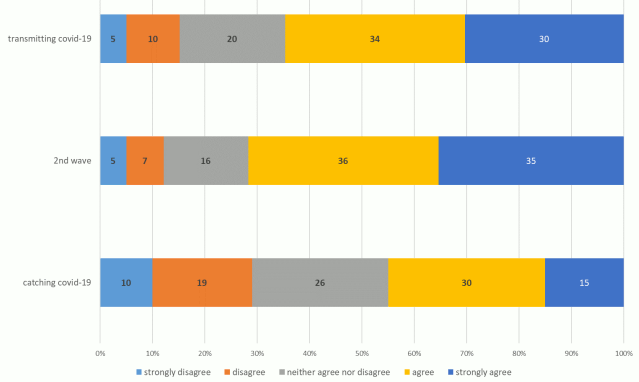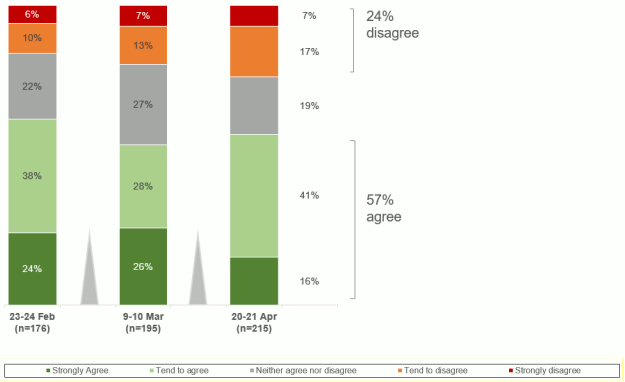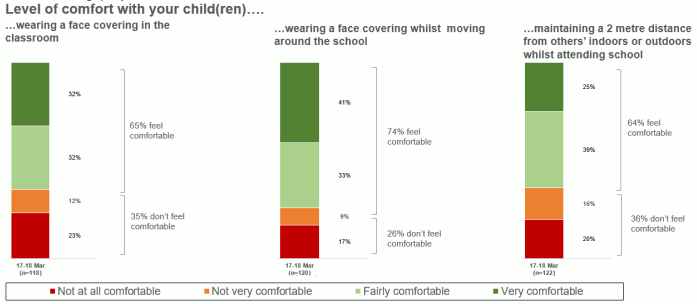Coronavirus (COVID-19) mitigation measures among children and young people: evidence base summary
Summary of the Scottish evidence base on the COVID-19 mitigation measures aimed at children and young people in Scotland
4. Attitudes to COVID-19 mitigation measures and safety
4.1 Evidence from children and young people
The qualitative research with vulnerable groups found that most children and young people agreed that it was important to implement COVID-19 mitigation measures. Many participants also said that there had been a good balance between freedom and restrictions. At the same time, many struggled with the long duration of restrictions and were upset about being unable to see their friends – some felt that rules were too restrictive in this regard.
In terms of face coverings, most children and young people had no problems with wearing face coverings where they were required. They were happy that they protected them and others. However, some children and young people found face coverings uncomfortable. They said it was hard to breathe while wearing one and gave them sore heads. Some young people were also unhappy with having to wear a face covering all day in school upon returning to in-person teaching. They did not understand the need for this and would have preferred wearing face coverings only in communal areas or to be given breaks to take the mask off.
Many children and young people felt unsafe whenever others did not wear face coverings or did not adhere to physical distancing. In these cases, they called for a stricter enforcement of measures – for example, in shops and public transport.
The non-representative Lockdown Lowdown 2 survey (28 September to 2 November 2020) asked young people who had returned to in person learning whether they felt that their educational establishment had re-opened in a safe way. Almost two thirds (63%) of respondents agreed that this was the case, while 17% disagreed.
The survey provided an opportunity for young people to highlight anything they would like changed about the current arrangements for their educational course. There were 2,543 freely typed responses to this question. Just under half of those young people did not want anything changed (1,140 responses).
A common theme emerged in the open text responses was that safety measures within their school needed to be enforced or increased. These measures included the use of face coverings, physical distancing and sanitisation practises:
"I think there should be more social distancing measures and stricter mask and hand sanitiser rules."
The Lockdown Lowdown 2 survey also asked young people how concerned they were about COVID-19. Around seven in ten were concerned about a second wave and just under two thirds were concerned about transmitting COVID-19 to others. Just under half were concerned about catching COVID-19 themselves. See Figure 4.1 below.

Chart showing the proportion of young people who strongly agree/disagree/neither agree nor disagree/agree/strongly agree that they were concerned about:
- Transmitting COVID-19
- A second wave
- Catching COVID-19.
The figure contains 3 charts, one for each statement. Data are from the Lockdown Lowdown 2 survey.
Source: Lockdown Lowdown 2 Survey
When asked if they had any further thoughts on these issues, around two fifths of the respondents (684 in 1,632 free typed responses) had no further comments. Common themes emerged from those who had further thoughts were fears around transmitting COVID-19 to others, decline of their mental health during the COVID-19 outbreak and worries about vulnerable family members.
In addition to the survey, the Lockdown Lowdown 2 project included five focus groups with a total of 37 groups of vulnerable young people aged 14 to 24[21]. The focus groups took place between 8 and 29 October 2020 and the following vulnerable groups were covered:
- Young carers
- Black Minority Ethnic young people
- Disabled young people
- Young people with experience of custody and/or the criminal justice system
- Care experienced young people.
The topic guides for the focus groups covered prompts on COVID-19 mitigation measures, with some additional detail in the disabled group. It should be noted that the focus groups took place in October 2020, prior to the new restrictions which made the wearing of face coverings mandatory in class for senior phase pupils. It should also be noted that the focus groups covered a wide range of topics, both specific to the lived experience of the particular vulnerable groups, and more widely on young people’s experience of COVID-19, and were not specifically focused on COVID-19 mitigation measures.
Young people in the focus groups were appreciative of mitigation measures taken in educational establishments. Participants also agreed with physical distancing, although some found it difficult to do in schools and when socialising with friends in public. Some reported their friendship groups not adhering to physical distancing. However, for others physical distancing was less of an issue during the summer period when meeting friends outdoors.
One place where many young people felt that mitigation measures and physical distancing were not adequately enforced was public transport.
The majority of participants agreed that face coverings should be worn in public and no participants expressed problems with wearing them in school. Some explicitly stated that they had no negative impact on them.
The only concern around face coverings raised was from a young carer, who felt that others were not wearing face coverings when required or not wearing them correctly, making them feel unsafe due to the impact that this might have on their family.
Young people that had an exemption from face coverings found that this was managed well through lanyards in both school and shops, although one participant had witnessed an incident where an individual with an exemption lanyard was stigmatised by another passenger on public transport.
The TeenCovidLife Survey 2 included some questions on how participants felt about returning to school after the first lockdown measures eased and schools re-opened and on wider safety concerns around COVID-19 in schools. Almost half of the participants (48% of the sample) claimed it was ‘pretty much’ or ‘very’ true that they were looking forward to going back to school and the majority (81% of the sample) said it was ‘pretty much’ or ‘very’ true that they missed friends from school.
Participants (1,958 in total) were asked how much they agreed or disagreed with the statement: “It is safe for me and other pupils to return to school full-time”. Young people were divided over whether or not it was safe for them to return to school following the first lockdown. Around a third (34%) agreed it was safe, while a similar percentage (36%) did not think it was safe. 30% neither agreed nor disagreed.
When asked “How do you feel about returning to school after the summer holidays?” (1,921 respondents), 42% said they were at least moderately worried, with a higher prevalence among female participants (48% compared with 30% of male participants). Young people were then asked “To what extent are the following statements true for you … I worry that returning to school will increase the risk of me getting COVID-19. I worry that returning to school will increase my family’s risk of getting COVID-19”. 6 out of 10 participants reported that it was ‘pretty much’ or ‘very’ true that they were worried that returning to school would increase the risk for their families, while 48% of the participants were worried for their own risk of contracting COVID-19.
4.2 Evidence from parents
Public Health Scotland ran the COVID-19 Early Years Resilience and Impact Survey (CEYRIS) Round 2, an online survey for parents of children aged 2–7, in November-December 2020[22]. This asked questions on the impact of COVID-19 and restrictions on young people and their families eight months into the pandemic. It was an open sample[23] survey and cannot be treated as representative of parents of children of this age. It was completed by 5,684 respondents. The second round of the survey started when COVID-19 cases declined and restrictions started to ease and schools/nurseries were open.
The vast majority of parents/carers (89% of the sample) agreed that they were confident that schools and childcare providers were doing what was needed to reduce the risk of infection and almost all the parents/carers (90% of the sample) agreed that their child was happy to return to school/childcare. 38% of respondents agreed that they were concerned about their child becoming ill with COVID-19, while 36% disagreed. Almost half of the parents/carers in the sample (47%) agreed that they were concerned that their child would pass the virus on to someone else, while 28% disagreed.
YouGov weekly polling from 20-21 April 2021 showed that most parents of children aged under 18 (73%) agreed that their child’s school/nursery had kept them well informed about safety measures in place to help prevent the spread of COVID-19 and over half of the parents (57%) were confident that schools and nurseries had the right measures in place to limit the risk of infection amongst returning pupils. Almost a quarter of the parents (24%) were not confident that schools and nurseries had the right measures in place. The percentage of parents who were not confident that the right measures were in place increased over time, from 16% in the polling from 23-24 February 2021 to 20% in 9-10 March 2021 and 24% in 20-21 April 2021[24]. See Figure 4.2 below.

Chart showing the proportion of parents who strongly agree/tend to agree/neither agree nor disagree/tend to disagree/strongly disagree with the statement “I am confident that schools and nurseries have in place the right measures to limit the risk of infection (amongst returning pupils)”. The figure contains 3 charts: 23-24 February 2021, 9-10 March 2021 and 20-21 April 2021. The data are from YouGov weekly polling.
Source: YouGov polling. Sample sizes: 23-24 February 2021 176; 9-10 March 2021 195; 20-21 April 2021 215. ‘Not applicable’ option excluded.
Around two fifths (42%) of parents of children under 18 agreed that they were worried about their children picking up or passing on COVID-19 at school or nursery, while 29% disagreed and 29% neither agreed nor disagreed. The percentages remained relatively stable between February and April 2021[25].
In terms of parents’ attitudes towards their children (11-18 years old) using lateral flow tests, the YouGov polling from 20-21 April 2021 showed that 73% of parents claimed they had authorised or will authorise their children to use the tests, an increase since 17-18 March 2021 (58%)[26]. However, 28% had not authorised their children to use the tests or were still undecided in April 2021.
YouGov polling from 17-18 March 2021 showed that:
- 65% of parents[27] of secondary school children were comfortable with their children wearing face coverings in the classroom
- 74% of parents[28] of secondary school children were comfortable with their children wearing face coverings whilst moving around the school
- 64% of parents[29] of secondary school children were comfortable with their children maintaining a 2 metre distance from others indoors or outdoors whilst attending school.
Overall while most parents of secondary school children were comfortable with the use of face coverings and maintaining a 2 metre physical distance at school, around a quarter to one third were not comfortable with these measures. See Figure 4.3 below.

Chart showing the proportion of parents who were not at all comfortable/not very comfortable/fairly comfortable/very comfortable with their children:
- Wearing a face covering in the classroom
- Wearing a face covering whilst moving around the school
- Maintaining a 2 metre distance from others’ indoors or outdoors whilst attending school.
The figure contains 3 charts, one for each statement. The data are from YouGov weekly polling 17-18 March 2021.
Source: YouGov polling 17-18 March 2021. ‘Not applicable’ option excluded.
A very small open sample, non-representative, poll carried out in February 2021 by Disability Equality Scotland on its website[30], among other open questions, asked respondents (84 respondents in total) if they had any concerns about the phased return to school for pupils across Scotland. Findings are to be interpreted with caution as the number of participants was very small. Respondents underlined the importance for parents/carers to comply with COVID-19 guidance. The following quotes provide examples of the issues covered:
“The big issue might come from parents dropping and picking up the pupils. They could easily mix with other parents and try to do their usual routine of chatting. They need to be strict and only drop off and then leave school. No mixing and no car sharing.”
“I am very concerned that physical distancing on school buses is impossible because my local council says they have no funding available to provide additional school buses. I will not be sending children to school because the school buses are badly overcrowded with standing room only.”
From a similar, again very small and non-representative, poll by Disability Equality Scotland conducted in March 2021[31] respondents (69 in total) were worried that pupils who had been exempt from wearing a face covering could be bullied and they based their worries on the abuse that adults who were exempted from wearing a face covering suffered in public places:
“I have an exemption card and you still get abuse and I am an adult and find it difficult so how will a child cope as school bullying is bad enough.”
Some parents were worried about the impact of face coverings on pupils with hearing impairments:
“It will have a huge, negative impact on our deaf children and others with sensory and communication barriers. Exemptions need to be better & clearer for them and adults in the general world!”
Finally, some respondents argued that the guidance on face coverings should be extended to all pupils, including those in primary schools, and that face coverings should be worn also when socialising outside of schools.
Disabled people (334 individuals) who participated in a similar poll in August 2020[32] also supported the use of face coverings in schools and on school transport. Similar concerns highlighted in the poll of March 2021 were also expressed in August 2020:
- stigma for those exempt from the regulations
- the impact of face coverings on pupils with hearing impairments and others who relied on lip reading and facial expressions for communications
- affordability and availability of face coverings
- the lack of use or enforcement of face coverings on school transport, particularly when school transport was shared with the general public.
In the qualitative research with vulnerable groups conducted by third sector organisations in 2021, parents/carers mentioned that physical distancing can be difficult for children without spatial awareness.
Parents with exemptions for themselves or their children noted ongoing stigmatisation and discrimination of people without face coverings. They said that exemptions had been misused and taken advantage of, and had lost their meaning. Therefore, some children, young people, and parents wore face coverings despite exemptions – both to avoid stigmatisation or because they did not want to wear a visible lanyard stating their disability.
“I am exempt, and it’s awful. When I am out in public, I have people watching, I hear whispering. I wear the lanyard but I still have people telling me to put one on. I have started wearing one sometimes now as its saves the whispering. I see Facebook posts saying people are lying to get out of masks and making up problems, like shaming you for being exempt, and they feel there are people faking it. In my college, there are posters to raise awareness that some people can’t wear them, but I still get questioned about it, from students and teachers even with the lanyard.”
(Parent with physical/mental illness)
Contact
Email: socialresearch@gov.scot
There is a problem
Thanks for your feedback